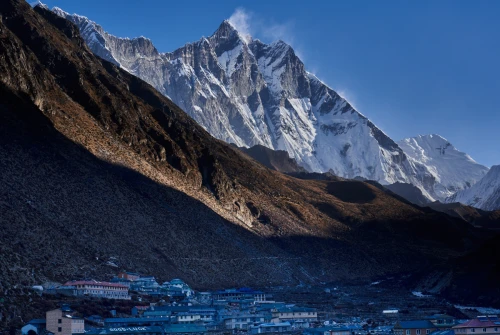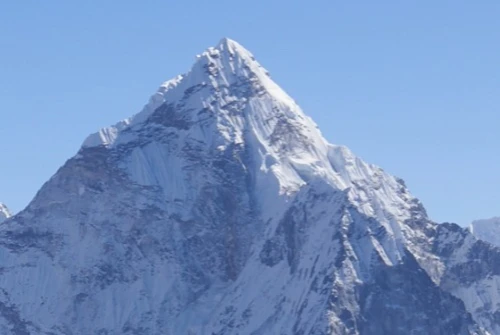Best Time for Everest Base Camp Trek by Road
Timing is everything when trekking in the Himalayas. The best time to trek Everest Base Camp by Road is spring (March to May) and autumn (September to November). During these months, the weather is stable, the skies are clear, and the mountain views are breathtaking.
Trekking in Spring brings blooming rhododendron forests, while autumn trekking offers crisp air and post-monsoon freshness. Winter treks are possible, but bring the risk of snow-covered trails and extremely cold nights. The monsoon season (June to August) should be avoided due to muddy roads, landslides, and poor visibility. If we’re looking for the perfect blend of scenery, comfort, and safety, spring and fall are unbeatable.
Difficulty Level and Fitness Required
The Everest Base Camp Trek by Road is classified as a moderate to strenuous trek, depending on our pace and level of preparation. The daily trekking hours usually range from 5 to 7, with longer durations on summit or descent days. Although the road journey allows for better acclimatization, the trek still involves high-altitude walking, steep ascents and descents, and cold temperatures above 4,000 meters. A good level of physical fitness, strong knees, and cardiovascular stamina are required. Prior trekking experience is helpful but not mandatory. With proper conditioning, mental determination, and a positive mindset, most fit hikers can complete the journey.
Accommodation, Food, and Drinks on the Trek
Accommodation along the Everest Base Camp trek route consists primarily of teahouses, which are local guesthouses offering basic yet comfortable lodging. Most rooms are twin-sharing with simple beds, blankets, and shared bathrooms. In larger villages like Namche, Dingboche, and Phakding, we can find more upscale teahouses with hot showers, flush toilets, and even Wi-Fi.
While luxury lodges exist in some locations, the charm of the teahouse experience lies in its authenticity. We sleep in wooden cottages, eat by warm stoves, and engage in conversation with fellow trekkers from around the globe. In Salleri and Kathmandu, the accommodation is more standard, ranging from hotels to cozy guesthouses with modern facilities.
Food availability on the trail is both diverse and surprisingly nutritious. Most teahouses serve a set menu of warm meals, with dal bhat (rice, lentil soup, and vegetables) being the most popular and replenishing choice. Other options include noodles, pasta, pancakes, eggs, Tibetan bread, and soups.
Meat is generally discouraged above Namche due to a lack of refrigeration. Beverages range from tea, coffee, and hot lemon to bottled or boiled water. Trekkers are advised to avoid untreated tap water and instead use purification tablets or carry a filtration bottle. Hydration is critical at altitude, so we must drink plenty of safe fluids throughout the trek.
Hence, to learn more about food, drinks, and accommodation on Everest, READ: Food, Drink, and Accommodation during Everest Base Camp Trek
Packing List for Road-Based Everest Trek
Packing efficiently is essential for the success and comfort of the trek. Core clothing includes layered outfits, thermal base layers, fleece, a down jacket, and a waterproof outer shell. Comfortable hiking boots are a must, along with trekking poles, a quality backpack, and a sleeping bag rated for sub-zero temperatures.
Don’t forget a wide-brimmed hat, sunglasses, gloves, and sunblock to combat intense UV exposure. Gadgets like a headlamp, power bank, and water bottle with a filter add functionality. Health items such as Diamox for altitude sickness, basic medicines, and blister care products should also be packed. Lightweight, weather-adaptive gear ensures a safer and more enjoyable experience.
Required Permits
Trekking in the Everest region requires two essential permits. First, the Khumbu Rural Municipality Permit (NPR 3,000) must be obtained either in Salleri or Monjo. Second, the Sagarmatha National Park Entry Permit (NPR 3,000) is available at the Monjo checkpoint or in Kathmandu.
These permits help fund infrastructure, conservation, and local employment in the region. It’s crucial to carry multiple photocopies of our passports and passport-sized photos for permit processing. If using a trekking agency, these documents are usually handled on our behalf, saving time and hassle.
Other factors to consider before heading to your Mount Everest Base Camp Trek, for your comfort.
Immunizations: Though Nepal doesn’t have official vaccination requirements for the Everest Trek, it is nevertheless a good idea to consider some vaccines before coming here. See the immunization chapter under Safety for more details. It is also a good idea to read the chapter on Pre-existing Conditions before leaving home.
Flight Tickets to Nepal
Before leaving your country, for the Everest Base Camp Trek in Nepal, book a Hotel. There are a lot of review-based web portals to book hotels in Kathmandu. However, it shouldn’t be much of a problem to get a room even if you haven’t booked in advance.
Nepal Visa Information
Obtaining a visa upon arrival at Tribhuvan International Airport in Kathmandu, Nepal, is a straightforward process. For a 15-day tourist visa, the cost is $40, and for a month-long visa, the fee is $50.
Lukla Flight Details
There are three airlines, namely Tara Air, Sita Air, and Summit Air, that operate daily flights to Lukla. These flights commence at 6:15 AM and continue until 12 AM. However, it's important to note that Lukla flights are susceptible to cancellations due to adverse weather conditions. Even during the peak season, flight cancellations can occur. In such situations, there's an alternative option of utilizing a helicopter service. A helicopter can accommodate 4 or 5 passengers, with a cost ranging from $350 to $500 per person. All Nepal Hiking prioritizes booking early flights for those who arrange their treks with us in advance.
Lukla Flight Weight Restrictions
There are weight limitations for flights to Lukla. Main luggage is restricted to 10kg, while hand luggage should weigh between 6-8kg. These limitations are in place to ensure the safety and efficiency of the flights to this remote region.
Essential Packing List
Selecting the appropriate items to pack for your trek can be a challenging endeavor, considering the length of your journey. To simplify this task, we have compiled a comprehensive packing list that takes into account the various necessities you'll need during your trek.
Headwear:
- Sun Hat
- Headscarf or Bandana
- Knitted Hat
- Neck Gaiter or Buff
- Headlamp
- Sunglasses
Clothing:
- Moisture-wicking Long Sleeve T-shirt
- Moisture-wicking Short-Sleeve T-shirt
- Down or Fleece Jacket
- Waterproof Jacket with Hood
- Fleece Pants
- Windbreaker
- Rain Poncho
- Insulated Jacket
- Trekking Pants
- Hiking Shorts
- Thermal Tops
- Thermal Pants
- Woolen Pants
- Sports Bra
- Moisture-wicking Underwear
Handwear:
- Wool or Fleece Gloves
- Waterproof Gloves
Footwear:
- Hiking Boots with Ankle Support
- Trainers or Running Shoes
- Light and Thin Socks
- Wool or Synthetic Socks
- Sandals or Slippers
Equipment:
- Duffel Bag
- Sleeping Bag (Certain equipment provided)
- Trekking Poles (Certain equipment provided)
- Daypack
- Thermosets
Accessories:
- Garbage Bag
- Water Bottle
- Water Bladder
- Stuff Sacks
- First Aid Kit
- Water Purification Tablets
- Sunscreen
- Lip Balm
- Hand Sanitizer
- Earplugs
- Wet Wipes
- Toiletries (Towel, Toothpaste, Toothbrush, etc.)
- Toilet Paper
- Extra Batteries
- Solar Power Bank
- Camera
Medical Kit Checklist
- Due to lax prescription requirements, most of the items are easier to get in Kathmandu.
- Povidone-Iodine cream- 1 tube
- Cotton- 1 roll
- Dressing Gauze- 5 pcs
- Crepe Bandage- 2
- Band-Aids- 10
- Dressing tape- 1
- Moleskine/ 2nd Skin- 1 packet
- Calamine- To aid in skin healing due to sunburns or chaffing.
- Paracetamol 300 mg- 20 tablets. For mild headaches.
- Ibuprofen 400 mg- 10 tablets. To relieve moderate to severe pain.
- Throat lozenges- 20 for cough and sore throat. It can be used preventively against the cold, dry mountain air.
- Decongestant- 10 tablets- For nasal congestion. Non-drowsy kinds like pseudoephedrine are recommended.
- Antihistamine 10 tablets- For allergies.
- Antiemetic 10 tablets- To control vomiting and nausea.
- Azithromycin 500 mg- 3 tablets. For bacterial diarrhea.
- Omeprazole 20 mg- 10 tablets. For gastric problems.
- Ciprofloxacin 500 mg- 10 tablets. For bacterial diarrhea.
- Tinidazole 2 g- 3 tablets (500 mg- 12 tablets). For Giardia and amoebic diarrhea.
- Acetazolamide (Diamox) 250 mg - 20 tablets. To aid acclimatization and AMS treatment.
- Dexamethasone 4 mg - 10 tablets. To be used under expert supervision to treat AMS.
- Nifedipine 60 mg - 10 tablets. To be used under expert supervision to prevent and treat HAPE.
- Loperamide 2 mg- 20 tablets. To control diarrhea.


 based on 9 reviews
based on 9 reviews
